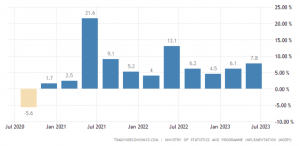
India reported encouraging GDP figures, signalling a rebound for the economy in this quarter, even as the world grapples with the repercussions of the Russia-Ukraine conflict and a broader macroeconomic slowdown. The Gross Value Added (GVA) surged to a four-quarter high of 7.8% in the first quarter of this financial year, according to official data. While this marks the highest GDP growth in four quarters, it still falls slightly short of the Reserve Bank of India’s (RBI) estimated 8% growth.
Nonetheless, India stands as the fastest-growing major economy, outpacing China, which recorded a 6.3% rise in the same quarter and is currently grappling with a fresh economic slowdown. India’s 7.8% growth is remarkable when compared to the 1-3% growth rates observed in various economies worldwide.
READ | Expanded BRICS can reshape the global economic order
However, India’s economy remains in the shadows, with economists expressing concerns about a weak monsoon, elevated inflation rates, and global headwinds potentially tempering growth throughout the rest of 2023-24. The upcoming months may prove more challenging as Indian goods exports and manufacturing have already taken a hit due to the global economic slowdown. The resurgence in inflation exerts pressure, and the likelihood of a weak monsoon threatens crop yields and farm incomes. This predicament compounds the financial strain on households, already burdened by soaring vegetable prices, such as tomatoes.
Sectoral analysis of GDP figures
India’s manufacturing GVA experienced growth for the second consecutive quarter after half a year of contraction. The growth rate slightly accelerated to 4.7% in Q1 of this year, up from 4.5% in the previous quarter. Other sectors, including agriculture, forestry, and fishing GVA, expanded by 3.5% between April and June. Previously sluggish service sectors reported a surge, significantly contributing to the economic momentum, with a robust growth rate of 10.3%. In comparison, the industrial sector, which includes construction, grew by a more modest 5.5%.
India GDP growth

However, concerns loom over India’s manufacturing sector, which grew at 4.7% despite expectations of double-digit growth. This is especially perplexing considering the decline in commodity prices. Economists attribute the sector’s lacklustre performance to the significant drop in trade, with merchandise exports contracting by 15% during the quarter. Nevertheless, there is an opportunity for a broader rebound in consumption demand. Although growth aligns with anticipated estimates, the manufacturing sector’s performance has been underwhelming, given the robust earnings reported by companies within the sector.
On the other hand, the agriculture sector, crucial for the economy, maintained a growth pace with GVA rising to 3.5% in Q1. However, the sector faces challenges due to the sluggish progress of the monsoon and concerns that low reservoir levels could impact the rabi crop. India experienced its driest August in 122 years, with rainfall plummeting to 33% below the seasonal average. States like Gujarat, Kerala, and Rajasthan were hardest hit by the rainfall deficit, halting agricultural activities in these regions.
The services sector delivered a strong performance, with trade, hotels, and transport registering a growth of 9.2%. However, in absolute terms, the labour-intensive segment remained 1.9% below pre-COVID-19 levels, indicating an incomplete recovery.
The road ahead
While the quarter showcased economic momentum, it is unlikely to be sustained. Growth is expected to moderate in the coming quarters. To ensure a desired pace of economic growth, the government must incentivize private spending, as government capital spending currently carries the load. A revival of the private investment cycle is essential.
Additionally, the government needs to monitor farmers’ income closely, as any dent in this sector could undermine the fragile recovery in rural demand. High inflation remains another concern, potentially stifling discretionary household spending. The government must formulate strategies to combat inflation while factoring in the effects of tighter global and domestic monetary policies.
According to the central bank, expansion will likely slow down to 6.5% in the second quarter (July-September), followed by 6% in the third quarter and 5.7% in the fourth quarter. These projections underscore the need for careful economic management in the challenging times ahead.
